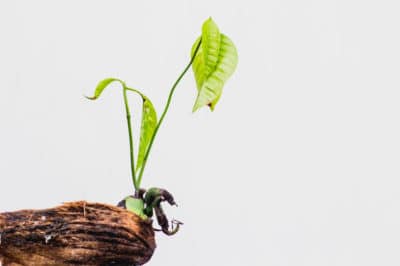Different Mangos Produce Different Type Seeds
What type of fruit your germinated and planted seed produces depends entirely on the type of seed you planted. There are two basic types of mangos: Indian and Indochinese. Although both are similar in looks of the tree and requirements for proper growth, the type of tree you get from a germinated seed is dependent on which of the two types of mangos you planted.
The differences in the two types of seeds include:
- Indian Mangos: Seeds are monoembryonic, which means due to hybrid crossing, the seedlings won’t necessarily resemble the parent tree. The mango fruit can be equal, superior or not as good as the mangos from the parent tree.
- Indochinese Mangos: Seeds are polyembryonic, which means seedlings are exact replicas of the parent tree and the fruit will be of the same quality. One seed can produce several seedlings.
Expert Tip: An easy way to tell what type of mango you have is by inspecting the color and shape of the fruit. Indian mangos are usually very colorful and the fruit has a standard mango shape. However, Indochinese mangos are elongated and less colorful, generally made up of greens and yellows.
Prepping for Germination & Planting
Due to handling procedures, such as cold storage, it’s not advisable to try germinating mango seeds from fruit purchased at your local supermarket. The success rate in germinating a supermarket mango seed is very low. The fresher the mango the better, and if you live in an area where they are grown, it should be easy to find them locally.
Once you have your ripe mango, it’s time to prepare your seed and plant.
- Clean all the flesh off the fresh seed and do not allow the seed to dry out.
- Using a sharp knife, carefully cut around the edge of the seed’s husk, revealing the inside, kidney-shaped kernel, and being sure not to nick the kernel. The husk should pop open.
- Fill a 3-gallon (11 liter) container with a well-drained potting mix. Make sure the container has bottom drainage to prevent the seed from rotting. Water the container’s soil to allow it to settle.
- Make an indentation in the center of the container and plant the seed, pointy side down. Allow the hump at the top to stick out of the soil about 1/4 inch. Water the soil again.
- Place the container in a partially sunny and warm location and water when the top inch of the container’s soil feels dry.
Time Schedule: Germination to Fruit
Your mango seed should germinate in anywhere from two to three weeks. Starting it off in a larger container means the germinated seed can continue developing into a decent size seedling before it requires repotting or planting in the ground. Once the mango seedling is 2 to 4 feet tall, its root system is developed enough to be planted into the landscape.
Trees grown from mango seeds won’t start flowering and producing fruit until they are around six years of age. However, it takes around 10 years for the mango tree to produce to its full potential.
